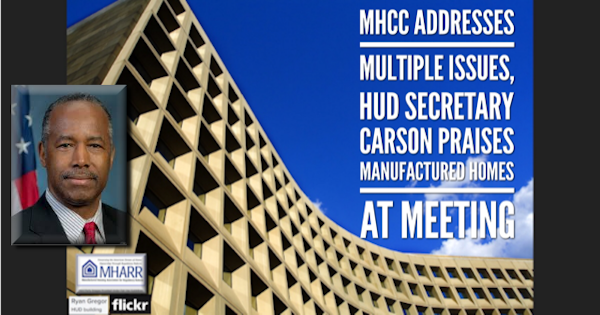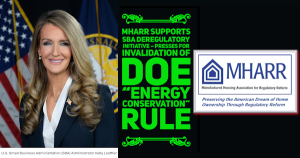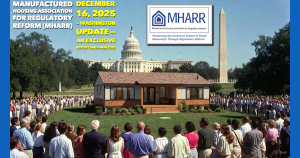- MHCC ADDRESSES MULTIPLE REGULATORY ISSUES
- MHCC CITES “MAJOR INACCURACIES” IN DOE-NODA
- SUBPART I TO BE REVIEWED AGAIN
- MHCC CALLS FOR WITHDRAWAL OF FROST FREE IB
- MHARR PROPOSAL ON MHCC ROLE ADVANCES
- PD&R REPORT OFFERS ON-SITE CHANGES
- HUD SECRETARY PRAISES MH IN ADDRESS TO MHCC
The Manufactured Housing Consensus Committee (MHCC) held its most recent in-person meeting in Washington, D.C. on April 30-May 2, 2019. The Committee, as detailed below, considered a number of regulatory reform and regulatory modification matters, including a response to the 2018 Notice of Data Availability (NODA) issued by the U.S. Department of Energy (DOE) concerning manufactured housing energy standards, a report prepared by HUD’s Office of Policy Development and Research (PD&R) concerning HUD’s needlessly complex and costly 2015 “on-site construction” rule, and proposals submitted to HUD pursuant to Trump Administration Executive Orders 13771 and 13777.
While the meeting offered some positive notes, both Committee members and others expressed frustration with the extremelyslow pace of action by HUD and the HUD program, not only in implementing years-old recommendations of the MHCC, but also, in achieving and actually implementing, specific regulatory reforms. Thus, while HUD and the current Secretary took decisive and necessary action to remove the former program administrator, not a single unnecessary or excessive manufactured housing regulation, not a single HUD pseudo-regulation, not a single sub-regulatory “guidance” letter, or other rogue regulatory action adopted in violation of notice and comment requirements, or other unnecessary or excessive mandates, has yet been repealed or significantly amended through final agency action, now more than half-way through the first term of the Trump presidency. Indeed, the onlymanufactured housing program actions/documents that have been officially retractedatallto date, pursuant to Executive Order 13777, as “obsolete,” are thirteen past issues of the program’s “The Facts” newsletter, issued by the former administrator, identified in an April 5, 2019 Federal Register notice.
And while HUD’s position — that proposed regulatory changes and regulatory reform proposals must be processed through the MHCC — is correct and consistent with the Manufactured Housing Improvement Act of 2000, there is no valid or legitimate reason for HUD’s failure to convene either the full MHCC and/or relevant MHCC subcommittees more than oncesince September 2018, or more than once per year, in order to expedite the consideration, adoption and, most importantly, the implementation of such changes in order to reduce regulatory compliance burdens (which disproportionately impact the industry’s smaller businesses) and related costs and inefficiencies imposed on homebuyers. Indeed, there is no legitimate excuse for failing to immediatelyschedule additional MHCC and MHCC subcommittee meetings, as necessary, right now, in order to complete a full and timely review of all pending regulatory and regulatory reform items for recommendations to HUD. Nor is any allegedlack of funding for such meetings a legitimate or valid excuse. Instead of over-funding a bloated monitoring contract, sufficient amounts can and should be re-directed to fund as many MHCC and subcommittee meetings as are necessary to complete a total review of all pending items in a matter of months not years.
In short, with reports that Secretary Carson may be leaving HUD at the end of President Trump’s first term, it is apparent that the institutional bureaucracy at HUD could be attempting to “buy time” and run out the clock on any genuine reform of the manufactured housing program. This is why MHARR has consistently maintained that two actions – as mandated by the 2000 reform law – are essential to the full and lastingreform of the HUD program, namely, the appointment of a non-career program administrator and full, fair and legitimate competition for the program monitoring contract (and, in fact, a new monitoring contractor after more than 40-years). These two institutional reforms must be accomplished, and MHARR will continue to aggressively pursue their realization.
MHCC DISPUTES MAJOR ELEMENTS OF DOE ENERGY PROPOSAL
Among its significant actions, the full MHCC adopted a final response to the U.S. Department of Energy (DOE) regarding 15 specific issues relating to manufactured housing energy standards, posed by DOE in a 2018 Notice of Data Availability (NODA). The MHCC, in modifying certain aspects of a draft response prepared and approved by the MHCC’s Regulatory Enforcement Subcommittee during an April 2, 2019 conference call meeting, focused on specific analytical and cost-benefit fallacies inherent in the DOE-NODA – as did MHARR in written NODA comments filed on September 17, 2018 – which, MHARR maintains, render the proposals set forth in the NODA fatally defective.
Among other things, the MHCC, in its response, emphasized that the NODA’s cost-benefit calculation (like the earlier June 2016 DOE proposed manufactured housing energy standards rule) significantly understates and underestimates regulatory compliance costs connected with the proposed standards. In addition, the MHCC noted that DOE efforts to compare the energy utilization and energy operating costs of manufactured homes with other types of homes on a per-square-foot basis, are inherently inaccurate, unfair and improper, and should instead be considered on a “whole-home” basis, as MHARR has consistently maintained since its initial comments to DOE’s “negotiated rulemaking” Manufactured Housing Working Group. Related to this point, the MHCC further criticized the NODA proposals for calculating alleged operating-cost savings arising from the proposed standards based on a 7-10 year payback period, noting that, in many cases, purchasers do not remain in their homes for that long a period, and instead recommended a 6-8 year payback calculation period based on a more realistic estimate of initial ownership and tenancy periods.
Beyond these specific cost-benefit-related comments and recommendations, the MHCC retained language from the original Subcommittee draft, noting that initial acquisition cost increases resulting from the proposed standards are – and should be — more analytically significant than long-term operating cost savings, because of the relative price inelasticity of manufactured housing and the likely exclusion of large numbers of potential purchasers as a consequence of standards-driven purchase price increases. This again, is consistent with earlier MHARR comments dating back to the DOE “negotiated rulemaking” process. Those comments, moreover, demonstrated – based on documents obtained through the Freedom of Information Act (FOIA) — that the entire DOE “negotiated rulemaking” process was a pre-arranged sham between DOE and energy special interests, among others. MHARR, as a result, has consistentlymaintained that the NODA, which, by DOE’s own admission, is based on cost-benefit data derived from that fatally-flawed “negotiated rulemaking” process, is itself, invalid, arbitrary and capricious, in violation of both federal manufactured housing law and the federal Administrative Procedure Act (APA).
Insofar as the MHCC NODA response takes issue with – and recommends against the use of multiple assumptions and data points underlying the NODA – that response, together with the comments previously filed by MHARR, provide a compelling case to DOE that the NODA proposals should be withdrawn as the product of an invalid and illegitimate negotiated rulemaking process, and that DOE should instead pursue a legitimate manufactured housing standards process based upon new data and new fact-finding, and a commitment to minimumstandards that promote maximum consumer choice and consumer freedom.
MHCC TO CONDUCT FURTHER REVIEW OF SUBPART I
Following 2014 amendments to Subpart I of the HUD Procedural and Enforcement Regulations first initiated by a July 2001 MHARR Petition for Rulemaking, the MHCC, based on regulatory reform proposals submitted by MHARR (denominated DRC-26) and others, voted to refer the matter of furtherSubpart I reform (or even possible elimination) to its Regulatory Enforcement subcommittee.
The recall and correction provisions of Subpart I, which as MHARR has stressed many times previously, are an artifact of the National Highway Traffic Safety Act, an automobile law, which — although inapposite to and inappropriate for housing — served as the model for the National Manufactured Housing Construction and Safety Standards Act of 1974. As a result, MHARR, for two decades, has called for either the elimination of Subpart I, or major Subpart I reform to eliminate its needless focus on either minor or non-existent issues, its excessive costs, and its excessive paperwork requirements, which provide little or no corresponding benefits for consumers, and its unlimited duration, which is unlike any other housing-related regulatory mandate.
Subpart I, moreover, as construed by HUD, has evolved into a virtually unlimited warrant and excuse for unreasonably intrusive actions and pseudo-regulatory abuses by HUD’s monitoring contractor, which has misused that authority to impose extremely costly demands and mandates on manufacturers that exceed or are otherwise not fully-based on existing standards and regulations.
Subpart I reform, accordingly, can and shouldgo well beyond the 2014 HUD amendments, in order to ameliorate the excessive costs and regulatory burdens imposed by the current Subpart I, while maintaining appropriate protection for consumers in relation to legitimate defects for a reasonable period.
MHCC RECOMMENDS WITHDRAWAL OF PROPOSED “FROST-FREE” IB
The MHCC, after a lengthy debate, approved a motion to recommend that HUD “never finalize” its pending Interpretive Bulletin (IB) on so-called “frost-free” foundation design for manufactured homes. The IB, published in the Federal Register on June 21, 2017, as demonstrated by MHARR’s written comments, would have substantively modified section 24 C.F.R. 3285.312 of HUD’s Federal Manufactured Housing Installation Standards – in violation of section 604 of the Manufactured Housing Improvement Act of 2000 — to effectively eliminate the current option in section 3285.312(b)(3) to base frost-free foundation designs on either American Society of Civil Engineers (ASCE) reference standard 32-01 or“acceptable engineering practice.” Instead the proposed IB, would establish an effective equivalence between ASCE-32-01 and “acceptable engineering practice,” thus eliminating the ability of a particular consumer in a particular area to select a frost-free foundation design customized for that location and certified by (i.e., bearing the seal of) a licensed architect-engineer. As a result, MHARR has consistently opposed this alleged HUD “interpretation” of 24 C.F.R. 3285.312(b), ever since it was first announced in an “Interim Guidance” document issued unilaterally by the former program administrator in April 2016.
After noting that the federal standard, as currently stated, provides consumers with reasonable options for the design of “frost-free” or “frost-protected” foundations and reasonable protection through the required certification by a registered architect engineer, the MHCC adopted a motion stating that “no changes are required to Part 3285 regarding frost-free foundations,” as well as a request (and recommendation) by the MHCC that HUD “never finalize” the proposed IB (denominated IB I-1-17) which currently, according to HUD, is not being actively pursued by the Department, but could be reactivated at a future date. Given this possibility of reactivation, the MHCC recommendation serves an important purpose in placing the full MHCC on record as opposing the substance and basis of the proposed IB.
MHARR PROPOSAL TO END BASELESS RESTRICTIONS ON MHCC ADVANCES
A regulatory reform proposal by MHARR (denominated DRC-2) seeking the repeal of a February 5, 2010 “Interpretive Rule” (IR) which unlawfully eliminated a major aspect of the MHCC’s review and recommendation functions, has been referred to the MHCC’s General Subcommittee for further review, together with other proposals relating to the function and role of the MHCC.
The MHARR proposal seeks to invalidate and repeal the IR, which effectively negates via alleged “interpretation,” section 604(b)(6) of the 2000 reform law. That “catchall” section of the law was designed to ensure that HUD could not avoid the MHCC consensus process (and notice and comment rulemaking) through the simple expedient of designating a de factochange to the Federal Manufactured Housing Construction and Safety Standards or Procedural and Enforcement Regulations to be a mere “interpretation,” “regulatory guidance,” or similar sub-regulatory action.
Repeal of the baseless 2010 IR – and restoration of the full role and function of the MHCC — is a crucial element of the regulatory reform of the manufacture housing program and the proper and effective implementation of EOs 13771 and 13777. Furthermore, and even more importantly, its repeal is key to ensuring that after the conclusion of the EO 13771/13777 process, and under a future administration, HUD does not revert to its old practice of imposing costly new mandates on manufacturers and consumers through a “backdoor” process of supposed “interpretation.”
MHCC TO CONSIDER CHANGES TO “ON_SITE” RULE
The MHCC will once again take up the issue of “on-site” completion, which has been a source of major controversy since HUD’s 2015 adoption of a final “on-site” rule which needlessly complicated – and significantly increased the cost of – a consensus “on-site” proposal that had previously been recommended by the MHCC (and supported by MHARR). MHARR, in its original EO 13771/13777 (departmental) comments to HUD and subsequent EO 13771/13777 comments specifically addressing the HUD program, sought significant changes to the final rule to lessen its cost and delay impacts without compromising appropriate consumer protection. And now, that MHARR regulatory reform proposal (denominated DRC-17) has been referred to the MHCC Regulatory Enforcement subcommittee, together with a preliminary report by HUD’s Office of Policy Development & Research (PD&R), which addresses and, on its face, appears to recommend certain on-site reforms that are consistent with those sought by MHARR.
In its report, which was presented to the MHCC as a non-final, “pre-decisional” document, PD&R appears to reject a delegation of on-site construction approval and inspection responsibilities to the states (which has been advocated by California and others), but does propose a reduction to the current 100% site inspection requirement in order to eliminate both unnecessary costs and needless time delays in securing final occupancy permits for on-site completed homes. This recommendation is consistent with MHARR’s long-standing call for targeted, representative inspections of on-site homes – rather than 100% “blanket” inspections – in order to ensure compliance and consumer protection, but at a lower cost and with less unnecessary delay, in much the same manner as the in-plant inspection and monitoring process. Both this and other reforms, designed to untangle the needlessly complex web of paperwork, inspections and 18 new regulatory mandates (at a minimum) which were established by the HUD 2015 final “on-site” rule, if considered and recommended by the MHCC, would go a long way toward restoring the original intent and purpose of the MHCC’s initial on-site proposal – to both expedite and lower the cost of on-site home completion and to provide consumers with additional home amenities that they seek.
The referral of this matter to a Subcommittee should thus represent the first step in a process to return the on-site completion process to the cost-effective and efficient process first envisioned by the MHCC nearly a decade ago.
SECRETARY CARSON PRAISES MH IN ADDRESS TO MHCC
HUD Secretary Ben Carson, in an unscheduled address to the MHCC, praised manufactured housing as a source of affordable homeownership which fills a “need which would otherwise go unmet.” Noting that manufactured housing is a “real priority” for HUD and that HUD, under his leadership, would be a “strong proponent” of manufactured housing, the Secretary pledged that HUD would work to “reduce regulatory barriers” to manufactured housing, while maintaining its quality, durability, safety and “affordability” for consumers.
While these comments are welcome, appropriate and appreciated, much remains to be done, as noted above, to translate these goals and objectives into concrete accomplishments – i.e., specific regulatory reforms – that will fully implement the regulatory reforms mandated by both the 2000 reform law and the Trump Administration, and advance manufactured housing a source of affordable, non-subsidized homeownership for millions of Americans. More than two years into the Trump Administration, the regulatory reform of the HUD manufactured housing program must become a reality, with specific, concrete policies and actions designed to fully clear-away the regulatory abuses of the past and ensure – finally – the full and complete implementation of all reform aspects of the Manufactured Housing Improvement Act of 2000. This has been and will remain MHARR’s first and highest priority.
MHARR.MAY 2019 MHCC MEETING REPORT.pdf














